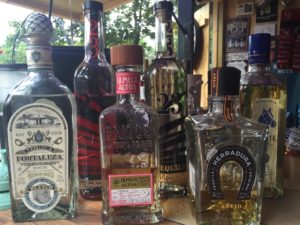
I have to admit that my pet bar project at the moment is getting people to think differently about tequila. So most visits include at some point me getting a bottle out and asking people to try it.
The conversation normally goes the same way. I suggest tequila, the guest pulls a face and says something about wanting to be able to feel their legs in the morning etc. But normally after a little gentle persuasion they play ball, followed by relatively appreciative murmurings when they’ve tried it. I don’t know if there’s a spirit more maligned or less well appreciated and understood … and I was about to say “on the supermarket shelves”. But there’s the rub!
The problem is that most of what’s readily available is a fairly poor excuse for tequila. A quick search on the major supermarket websites returns Sierra, Jose Cuervo and the occasional bottle of Patron. Of course many spirits are in similar boats with the usual big name selection of vodkas and rums, but most other spirits are benefitting from more discerning purchasers stocking the shelves with a few more unusual offerings. But like most drinks you only really get a feel for what’s available when you start looking at specialist drinks retailer sites or if you happen to have somewhere a bit different available to you.
So, largely, tequila still lives in the shadow of the reputation it got, with most of us, from our earlier years. A thing to be chugged on holidays or student nights out, with some table salt and a lime wedge. Of course both those accompaniments are designed for one purpose …. to shield you from the fairly foul tasting throat burner you’re about to throw down your neck. And, no, it’s not the traditional way to drink tequila!
So who’d have known that Tequila is actually a city in the Mexcian state of Jalisco. And the drink is now (since the late ’90s) regionally protected, in much the same was as champagne or the cornish pasty. If it’s not made in the designated region around Jalisco then the similar drink is sold as something we know as mezcal.
What also distinguishes tequila is that it’s made from the heart of the blue agave; a squat cactus like plant with large fleshy spikes, not dissimilar to the aloe vera. And the area in whch it’s grown ranges in soil and elevation making for a diverse nature that can be seen in different tequilas. The blue agaves grown in the highlands of the region tend to be larger and sweeter, the lowland varieties more herbaceous and aromatic. And this comes through in the finished product.
If there’s one thing to look out for in any discerning tequila purchase it’s to ensure that the bottle says that it’s 100% blue agave. The tequila we know and hate from our earlier days was almost certainly “mixto”, a less well controlled cocktail of ingredients and often cheaply produced. That’s not to say that all mixto is bad. After all, a blended whisky can be very well done but generally the better quality and greater diversity lies in the single malts. The same principle applies with tequila.
The production process
The blue agave plants are grown on plantations for typically six to ten years before harvesting. The leaves are removed revealing a substantial heart known as the ‘pina’ which can weigh up to three hundred pounds. It’s the pina’s starchy centre that produces the sugars for fermentation and distillation into tequila. The pinas are cooked slowly for up to two days before being crushed for their sugary juice.
There are three types of tequila to look out for; Blanco (silver), Reposado and Anejo. Blanco is bottled immediately after distillation so is clear in colour. Reposado is aged in wooden barrels for up to a year and Anejo for over a year. The ageing adds colour and complexity as the spirit extracts flavours from the wood and whatever was previously stored in it – often bourbon. But Blanco retains more of the pure flavour of the agave and the production process. It’s often assumed that Reposados and Anejos are superior to Blancos but that’s very much a personal taste. Put simply, the process is longer so the product is more expensive. And while the ageing can round off the harsher edges of some Blancos there are plenty of examples where the initial spirit is smooth and flavoursome in its own right and can be just as interesting for the retention of that more natural flavour of the agave.
And don’t get confused by coloured tequila called ‘gold’. It’s not aged. It’s just basic mixto tequila with some caremalised sugars added for colour.
The drinking
So here’s where the fun starts! Yes, of course, you can still throw good tequila down your neck with some salt and lime if that’s your thing. But the Mexicans have a different way to enjoy the stuff. And, if you do choose to seek out some quality tequila I strongly recomend their approach which I think is the best way to enjoy the flavours of a really interesting spirit.
And that’s simply at room temperature, straight, no ice and possibly with a ‘sangrita’.
So what’s a sangrita then? Well its a drink that has no real recipe. It’s one of those things where every family or tequila bar will have its own take on how to make it. But typically it’s made from blood orange juice, some pomegranate molasses, lime juice and chilli. Some include tomato juice and certainly that’s a staple of the bottled varieties available in the Mexican shops but I’ve seen lots of websites saying that traditionally it’s just an orange based drink. So you can see there’s plenty of room for interpretation and personal taste. I’ve made a few batches of sangrita myself using different ingredients and the simple truth is that if you like it then it’s good. I add things like BBQ spice rub powders; basically whatever I’ve got laying around to make a drink that’s fruity but with a little kick.
Typically the sangrita is sipped alternately with the tequila, but not, I hasten to add, to disguise the taste. Again, we’re talking here about a clean, warm and interesting spirit full of flavours of toasted sugars and a grassy spicyness.
But other than just straight up, whether with a sangrita or not, tequila is a killer cocktail ingredient. We all know the Margarita, although I dare to suggest that a lot of people’s experience of margaritas might be an overly limey, iced version that doesn’t have the brilliance of a well balanced short margarita made with an excellent blanco or reposado tequila. But there are a host of other cocktails specifically designed for tequila or for which tequila can be an interesting substitute for the more standard spirit.
So I think the subject warrants a closer look. So how about a margarita mixing video next weekend and some suggestions for other great tequila cocktails? And I’ll review the 5 tequilas I have in stock, with particular bias, I have to admit, to my current favourite … Fortaleza blanco.

